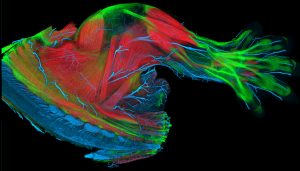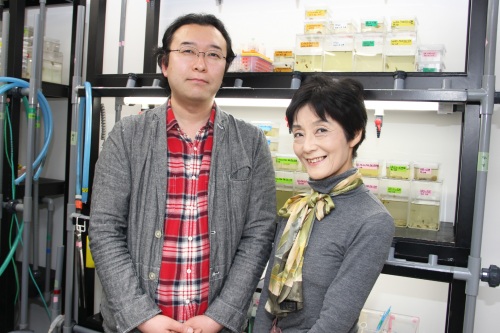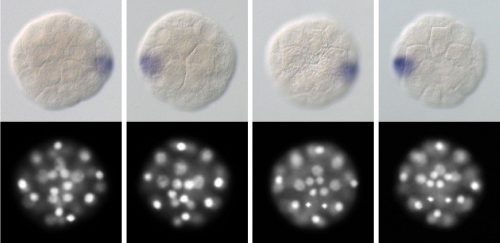Beyond morphogen signaling
Posted by Holley Lab, on 25 June 2019
By Dörthe Jülich & Scott Holley
Organizers pattern surrounding tissues via secreted morphogens that specify different cell states as a function of concentration. Wolpert’s French Flag model is commonly used to describe how morphogen gradients specify different fates. Our recent study integrates tail organizer signaling with control of morphogenesis during vertebrate body elongation (Das, Jülich, Schwendinger-Schreck et al., 2019). This figure shows a French Flag in the background, and a reconstruction of tracks of cell motion in the zebrafish tailbud (posterior is down and anterior is up). The tail organizer is green, the posterior neural tube is magenta, the presomitic mesoderm is cyan, and the domain containing the neural-mesodermal progenitors is red. We found that Bmp signaling is confined to the posterior of the organizer, but that cell motion in the posterior neural tube is affected by organizer signaling. Mechanical perturbation of the organizer has similar long-range effects. We hypothesized that local perturbation of signaling and cell motion in the organizer is propagated by a cell to cell relay (yellow) to affect cell motion in the posterior neural tube. We called this effect mechanical information, and propagation of mechanical information beyond the range of morphogen signaling enables embryonic organizers to expand their sphere of influence.
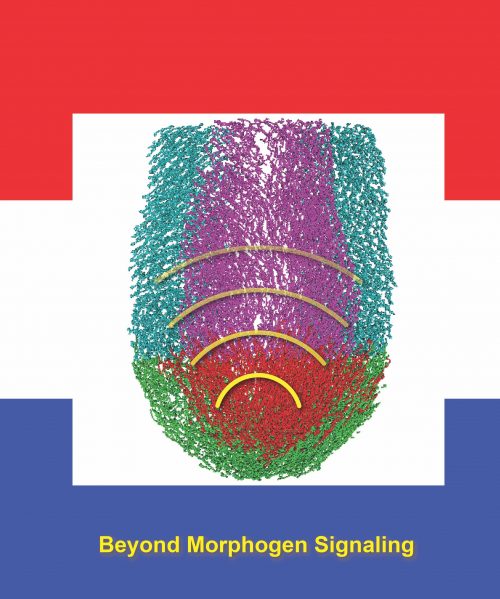
This study started as a side project during Jamie Schwendinger-Schreck’s doctoral research. Andrew Lawton and Nicolas Dray, a former graduate student and postdoc in the lab, respectively, had developed methods for systematically analyzing cell motion in the zebrafish tailbud. Andrew’s thesis research described the effects of inhibition of Wnt and Fgf signaling on cell motion and found that regulation of tissue fluidity is essential for normal body elongation. Bmp signaling is also localized in the posterior tailbud, and prior studies in Xenopus and zebrafish had linked Bmp signaling and the transcription factor eve1 with ‘tail organizer’ activity, i.e. manipulation of organizer signaling could cause tail duplications. Jamie performed these initial experiments with help from Andrew and Nico. She found that even though Bmp signaling was localized to the posterior tailbud, after perturbing the organizer, she observed effects on cell motion far from the Bmp signaling domain. This seemed pretty interesting, but we were stuck with no physical explanation of our observation and no direct experimental validation that the effects were truly non-autonomous to the Bmp signaling domain. Meanwhile, Jamie graduated, as students are wont to do, and there was no one in the lab working on the project.
Dipjyoti Das, a theoretical physicist who goes by ‘Dip’, joined the lab as a postdoc, and with our collaborator Thierry Emonet, who has expertise in fluid mechanics, developed a 3D computational model of the elongating tailbud. In silico experiments are faster and less resource intensive than wet lab experiments, and we wanted to see if we could explain the long-range effects that Jamie observed using the computational model. Corey O’Hern and Mark Shattuck are theoretical soft matter physicists with whom we also collaborate. Their expertise in the physics of granular matter guided our in silico experiments, and Dip observed signatures in the tailbud simulations analogous to pressure waves traveling through granular matter, i.e. similar to someone tapping on one end of a table and a second person sensing the vibrations at the opposite end of the table. The model led us to look for this signature in our in vivo data, and remarkably, we observed the same phenomenon in the in vivo cell motion data.
Once we had a physical explanation for our observation, we needed additional in vivo experiments test the idea that a localized change in cell signaling could instigate a relay effect that alters cell movement indirectly and far from the signaling domain. Optogenetics was the obvious way to proceed. Dörthe, a Research Scientist in the lab, spent the better part of a year trying unsuccessfully to establish an optogenetic perturbation. She’s an experimental maestro, so when she couldn’t get the optogenetics to work, we had hit another wall.
Dörthe thought that, given more time, she could get optogenetics to work. That may very well be true, but the project was already taking years longer than anticipated. Here, we needed to avoid having the perfect be the enemy of the good. We had some alternative ideas for experiments, but they wouldn’t be as elegant as an optogenetic perturbation. These experiments were still technically challenging, and Dörthe got them to work after considerable trouble-shooting. Emilie Guillon, a postdoc in the lab, and Dip helped with the data analysis. These data supported the hypothesis that perturbation of the tail organizer has indirect effects far from the organizer signaling domain. The effect travels at a rate too rapid to be mediated by transcription and translation, and we hypothesize that it is propagated as a relay from cell to cell as the cells migrate during body elongation.
Two of the joys of being a scientist are seeing a complicated multi-year project to completion and discovering something new. This project started with the intent of Jamie getting a ‘quick’ additional paper to round out her dissertation. As it often goes in science (and in life), reality intervened and things did not go according to plan. After Jamie graduated, we received an NIH grant to pursue this research, and that grant ended in 2017 as we began writing the first draft of the manuscript. Jamie is now a Scientific Project Manager at 10x Genomics. Dip is starting his own lab as an Assistant Professor at the IISER, Kolkata. Dörthe is on a well-deserved vacation hiking in the arctic circle. After I submit this blog post, I will go on a literal fishing expedition with friends from college. We still do not know how the mechanical information is propagated nor how general this mechanism is. When I return from vacation, I look forward to being surprised by the next experiment. Who knows to where it might lead?
Das, D.*, Jülich, D.*, Schwendinger-Schreck, J.K.*, Guillon, E., Lawton, A.K., Dray, N., Emonet, T., O’Hern, C.S., Shattuck, M.D. and Holley, S.A. 2019. Organization of embryonic morphogenesis via mechanical information. Dev Cell, 49: 829-839. * equal contribution


 (5 votes)
(5 votes) (8 votes)
(8 votes)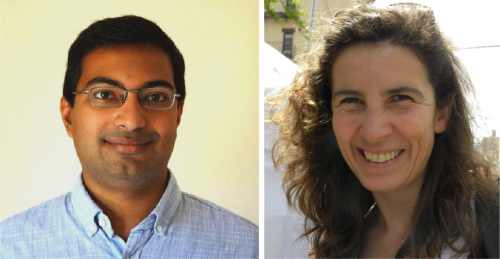
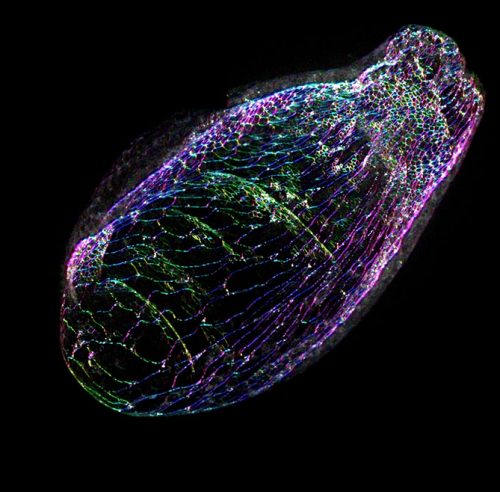
 (No Ratings Yet)
(No Ratings Yet)




 What did Watson and Crick discover? Rosalind Franklin’s notes…
What did Watson and Crick discover? Rosalind Franklin’s notes…